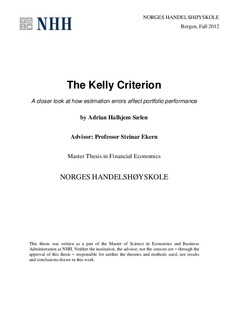The Kelly criterion : a closer look at how estimation errors affect portfolio performance
Abstract
The Kelly criterion are being used by many succesful investors and are often linked to their success in amassing great fortunes for both themselves and the funds they are running. This simple formula has made such a great impact on their results, that it is often cited as the main reason for these fund managers outperforming the indexes and other investors. However, there are several problems with using the Kelly criterion, and the main one involves the big risk that is being taken by sizing ones portfolios using the formula.
This thesis will show that the problem with large risk becomes even greater when the errors in our estimation of the inputs start to get larger and larger. When our investor’s estimation errors increase, the volatility of the portfolio will not only increase as a result of this, but the growth of the wealth will fall. The conclusion that can be drawn from this is that risky assets, that is, assets that are very hard to determine the actual returns and volatility of with good accuracy, should use a fractional Kelly size ( ) when investing, to avoid overbetting on the asset, or even refrain from using the Kelly criterion at all.
